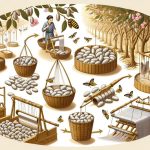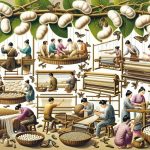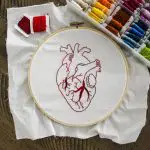Do you ever wonder how many silk cocoons it takes to create one yard of fabric?
In this article, we will explore the fascinating process of transforming silk cocoons into luxurious fabric. By understanding the silk extraction method, factoring in quality, and considering innovative production techniques, you can maximize the fabric output from silk cocoons.
So, if you’re curious about the science behind silk production, keep reading to uncover the secrets of this ancient art.
Table of Contents
Silk Cocoon Production Process
To make one yard of silk fabric, you’ll need to harvest and process around 2,500 silk cocoons. Silk cocoon harvesting is a delicate and time-consuming process that requires skill and precision.
The first step is to carefully extract the cocoons from the silkworms. This is done by gently unraveling the silk threads that hold the cocoon together.
Once the cocoons are collected, they are then boiled in hot water to soften the silk fibers and remove any impurities. This is known as silk fiber extraction.
After boiling, the cocoons are ready to be unwound. Each cocoon contains a single strand of silk that can be up to 900 meters long.
To obtain the silk fibers, the cocoons are placed in a machine that unravels the silk strands. The fibers are then spun together to create silk yarn, which is used to weave the fabric.
The entire process of silk cocoon harvesting and silk fiber extraction requires careful attention to detail and patience, resulting in the luxurious silk fabric that we all love.
The Transformation of Silk Cocoons Into Fabric
So, you want to know about the process of transforming silk cocoons into fabric? Well, it all begins with the cocoon harvesting. During this stage, the silk fibers are carefully unraveled and collected.
After the harvesting, the silk is spun into threads. This is done by twisting the fibers together to create a strong and durable thread.
Once the threads are ready, they are woven into fabric. This is done by interlacing the threads in a specific pattern to form a cohesive piece of cloth.
The end result of this intricate process is the beautiful and luxurious material we know as silk. Its softness, sheen, and breathability make it a highly sought-after fabric in the fashion industry.
Cocoon to Fabric Process
The process of turning silk cocoons into fabric involves boiling the cocoons to soften the silk fibers. Once the cocoons are boiled, the silk thread can be extracted. To extract the silk thread, the boiled cocoons are carefully unraveled, and the silk fibers are collected. These silk fibers are then spun into thread, which is used to weave the fabric.
Silk fabric manufacturing requires a delicate and intricate process. Each silk cocoon can produce around 300-900 meters of silk thread, depending on the size and quality of the cocoon. It takes approximately 2,500-3,000 cocoons to make one pound of silk thread. This means that it would take around 2,500-3,000 cocoons to produce one yard of silk fabric.
Silk Fabric Production
If you want a soft and luxurious fabric, silk is a great choice for your project.
Silk fabric production begins with silk cocoon harvesting. Silk cocoons are carefully collected from silk moths. The cocoons are then sorted and graded based on their quality.
Silk cocoon grading is an important step in determining the value and quality of the silk fabric that will be produced. The grading process involves assessing factors such as the size, color, texture, and overall condition of the cocoons. Only the highest quality cocoons are selected for further processing.
Once the cocoons have been graded, they are carefully unraveled to obtain the silk fibers. These fibers are then spun into threads, which are woven together to create the luxurious silk fabric that is loved by many.
Understanding the Silk Extraction Method
To understand the silk extraction method, you’ll need to know how many silk cocoons are required to make one yard of fabric. Silk extraction methods vary depending on the desired quality and type of silk being produced. The most common technique is known as the reeling method, where the cocoons are gently unwound to extract the silk filament.
Typically, it takes around 2,000 to 3,000 cocoons to produce one pound of raw silk. From this, about 4 to 8 pounds of raw silk are needed to create one yard of silk fabric. This means that approximately 8,000 to 24,000 cocoons are required to make one yard of fabric.
Silk production techniques have been refined over centuries to ensure the highest quality silk is obtained. Harvesting the silk cocoons at the right time is crucial to ensure the silk filament is intact and of optimal length. The cocoons are then carefully sorted based on their quality and suitability for different types of silk fabric.
Once the cocoons are selected, they are immersed in hot water to soften the sericin, a natural protein that holds the silk filament together. The softened cocoons are then ready for the reeling process, where the silk filament is carefully unwound and spun into threads. These threads are then dyed, woven, and finished to create the luxurious silk fabrics we all adore.
Factors Affecting Fabric Yield From Silk Cocoons
When considering factors that affect the yield of fabric from silk cocoons, you should focus on the quality and length of the silk filament. These factors play a crucial role in determining the amount of fabric that can be obtained from each cocoon. The silk filament is the raw material used to weave silk fabric, and its quality directly impacts the final product.
Silk cocoon harvesting techniques also influence the fabric yield. Traditional methods involve boiling the cocoons to loosen the silk filaments and then carefully unravelling them. However, this process can lead to breakage and shorter filaments. To maximize fabric yield, new techniques have been developed, such as using enzymes to dissolve the silk gum and gently stretching the filaments.
Market demand for silk cocoons also affects fabric yield. When there is high demand for silk products, producers may prioritize quantity over quality, resulting in shorter silk filaments and lower fabric yield. Conversely, when there is a higher demand for high-quality silk fabric, producers may focus on harvesting techniques that preserve the length and quality of the silk filaments.
Calculating the Silk Cocoon to Fabric Ratio
In this discussion, you’ll explore the cocoon-to-fabric conversion rate and the factors that can affect the yield of silk fabric.
Understanding how many silk cocoons are needed to produce a certain amount of fabric is crucial in the silk production process. Factors such as the quality of the silk, the size of the cocoons, and the processing techniques used can all influence the final fabric yield.
Cocoon-To-Fabric Conversion Rate
You can determine the cocoon-to-fabric conversion rate by calculating how many silk cocoons are needed to create one yard of fabric. This rate is important in the silk industry as it helps manufacturers understand the quantity of raw materials required for silk fabric production.
Here are some key points to consider:
-
Silk fiber extraction: Silk cocoons are carefully unraveled to extract the silk fibers. This process is done by boiling the cocoons in hot water to soften the silk fibers.
-
Cocoon weight: Each silk cocoon weighs around 2-3 grams on average.
-
Fabric weight: One yard of silk fabric typically weighs around 100 grams.
-
Conversion rate: Based on the average cocoon weight and fabric weight, it takes approximately 30-50 silk cocoons to produce one yard of silk fabric.
Understanding the cocoon-to-fabric conversion rate helps silk manufacturers plan their production process and calculate the quantity of silk cocoons needed to meet the demand for silk fabric.
Factors Affecting Yield
The factors that affect the yield of silk fabric include the weight of the cocoons and the desired fabric weight.
When it comes to silk cocoon harvesting, the weight of the cocoons plays a crucial role in determining the amount of fabric that can be produced. The heavier the cocoons, the more silk thread can be extracted from them. This means that a higher yield of fabric can be obtained.
Additionally, the desired fabric weight also affects the yield. If a lighter fabric is desired, fewer cocoons will be needed to produce the desired length. However, if a heavier fabric is desired, more cocoons will be required.
Therefore, both the weight of the cocoons and the desired fabric weight are important factors to consider when determining the yield of silk fabric.
The Role of Quality in Silk Cocoon Yield
High-quality silk cocoons typically yield a greater amount of fabric per yard. When it comes to silk cocoon quality and grading, there are several factors that come into play:
-
Size: Larger silk cocoons tend to produce more fabric compared to smaller ones. This is because they contain more silk filament, which is the raw material used to create silk fabric.
-
Texture: Silk cocoons with a smooth and even texture are easier to unravel and extract silk filament from. This results in a higher yield of fabric per yard.
-
Strength: High-quality silk cocoons have strong and resilient fibers. This means that the silk filament extracted from these cocoons can be spun into a finer and more durable fabric, thus increasing the yield.
-
Purity: Silk cocoons that are free from impurities, such as dirt or damaged fibers, can be processed more efficiently. They require less sorting and cleaning, resulting in a higher yield of pure silk fabric.
Innovations in Silk Production Techniques
Now that you understand the importance of quality in silk cocoon yield, let’s explore some of the advancements in silk production techniques.
Over the years, there have been significant developments in the field that have led to more sustainable and efficient methods of producing silk.
One notable advancement is the implementation of sustainable silk techniques. Traditionally, silk production involved the killing of silkworms to extract the silk thread from their cocoons. However, with the growing demand for cruelty-free and eco-friendly products, alternative methods have been developed. These methods focus on allowing the silkworms to complete their life cycle and emerge as moths before harvesting the silk. This not only avoids harm to the silkworms but also results in a more durable and lustrous silk fabric.
Furthermore, advancements in technology have also played a crucial role in improving silk production. Automated systems have been introduced to streamline the process of rearing silkworms, cocoon collection, and silk extraction. These systems ensure greater precision and efficiency, resulting in higher yields and reduced labor costs.
Maximizing Silk Fabric Output From Silk Cocoons
To maximize your silk fabric output from silk cocoons, you’ll want to focus on efficient techniques and technologies that increase yield and reduce waste. Here are four ways to optimize silk cocoon utilization and improve your silk fabric manufacturing techniques:
-
Use automated silk reeling machines: These machines can extract silk threads from cocoons with minimal waste and high efficiency. They ensure maximum utilization of silk cocoons and save time compared to manual reeling.
-
Implement sorting and grading systems: By sorting and grading cocoons based on their quality and size, you can allocate them appropriately for different fabric types. This ensures that each cocoon is used to its full potential, resulting in higher fabric output.
-
Explore silk degumming methods: Degumming is the process of removing the sericin, a natural gum-like substance, from silk threads. Using advanced degumming techniques not only improves the silk’s overall quality but also increases the yield of usable silk fabric.
-
Invest in silk waste recycling: Silk waste, such as broken cocoons and leftover silk fibers, can be recycled into other products like silk paper or even blended with other fabrics. This reduces waste and maximizes the utilization of silk resources.
Conclusion
To conclude, the number of silk cocoons required to produce one yard of fabric can vary based on several factors.
The silk extraction method, quality of the cocoons, and innovative production techniques all play a role in maximizing fabric output.
While there is no fixed ratio, understanding the process and factors affecting fabric yield can help in calculating the required number of silk cocoons.
By continuously improving production methods, the silk industry can strive towards achieving higher fabric yields from silk cocoons.
- How Does Ring Spun Cotton Affect Garment Fit and Shape Retention? - August 13, 2024
- What Are the Challenges in Producing Ring Spun Cotton? - August 13, 2024
- Is Ring Spun Cotton Suitable for Plus-Size Clothing? - August 13, 2024






